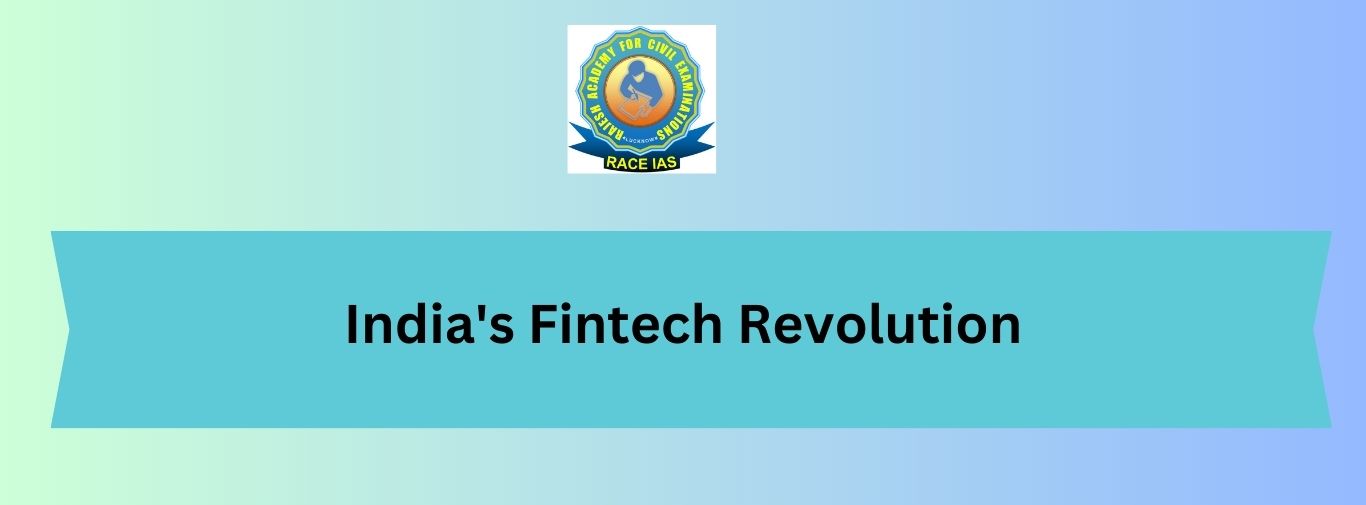
India's Fintech Revolution
India's Fintech Revolution
Relevance – GS Paper III (Economic Development)
Theme : Microfinance
Today India stands at a radical transformation into the financial section of its economy because of the speedy growth of FinTech or Financial Technologies. The efficiency of FinTech in Indian economy has rapidly caused the reshaping of delivery of financial services, facilitating inclusion and innovation.
What is FinTech ?
FinTech stands for Financial Technologies that include new technologies seeking to improve and automate the delivery and use of financial services. It is used to help companies, business, owners, consumers in managing their financial tasks like operations, processes and lives. It is made up of special software and algorithms used on devices such as computers and smartphones.
Fintech in India
- The once fully cash dependent Indian Economy has been transformed by the evolution of technologies and digital services in India.
- FinTech has carved its footprints in India in the past two decades and as an efficient result, today the era is widely referred to as 'techade'.
- Techade refers to the inclusion of technologies, innovation system, human centric and progressive policies.
- India is recognized as a global hub for technology and innovation in the digital economy along with a promising outlook for future.
Coverage of FinTech in India
- Financial Technologies involves various sectors and industries like education sector, retail banking, fundraising and nonprofit, investment management etc.
- Financial Technologies include the core development and use of crypto currencies such as Bitcoin
Factors contributing for India's FinTech revolution
- Skyrocketing e-commerce and arrival of smartphones
- Integrated ecosystem – Discussions of ideas by all participants (government agencies, financial research institutions, technology experts etc.) who turn the potential of market's FinTech for business and economic growth.
- Innovative steps – Relative lowering of the incidence of fraud by the means of globally recognized Indian innovations through AFA (The Additional Factor of authentication) followed by a PIN or OTP.
- Government's initiatives towards inclusion and innovation-
- PM Jan Dhan Yojana : The largest financial inclusion initiative of the world. It is considered as a liberation of poor from a vicious cycle of poverty. It provides digitized banking facility to all households in the country. It also ensures the availability of savings account, basic credit, remittances facility, insurances etc.
- e – RUPI : The cashless and contactless method for digital payment through a QR (Quick Response) code or SMS delivered to the mobiles of the users. It is developed by NPCI (National Payments Corporation of India).
- India Stack : It is a set of API (Application Programming Interface) that allows governments, businesses, startups, developers to use a unique digital infrastructure. It contains of three layers of open APIs - identity, payments and data. Some of the APIs that are a central part of India Stack – Aadhaar Proof, Aadhaar e-KYC, e-Sign, Digital Locker, UPI
- FASTag : Reloadable tag that allows automatic deduction of toll without stopping the vehicles for cash transactions. It uses RFID technology (Radio Frequency Identification) which is used on the windscreen of the vehicle once active. It provides the ease of payment.
- International Financial Services Centre Authority (IFSCA) : Announcement for development of world class FinTech hub at the GIFT-IFSC has been done by the government in the Union Budget 2021-22.
- Initiatives for financial literacy : Government launched various measures such as NCFE (National Centre for Financial Education), RBI's Centre for Financial Literacy project.
- Infinity Forum – The forum has to focus on how technology and innovation can be leveraged by the FinTech industry.
Challenges faced by the FinTech firms
- Data Security threat : The automation of processes and digitization of content or data make the system of FinTech loose and vulnerable to hacker attacks.
- Improper Regulation : It is a very difficult task to formulate single dimensional approach in FinTech sector due to its coverage of diverse offerings. Due to the same reason, most countries keep it unregulated that results in building the base for scams and frauds.
- Privacy concerns – consumers face variety of questions retrieving their personal information and important financial data that can be misused later.
- Industry-related complexities : FinTech are systemized to work with sophisticated working model which causes for them difficulty in maintaining smooth relationship with other financial institutions like banks.
- Reputation loss : Sometimes the other financial institutions like banks are afraid to work with FinTech as they risk their reputation loss.
- Cross border payments – Despite all the challenges , this one remains still unchartered territory of Fintech.
- Lack of access – The equal access to FinTech services may not be present everywhere.
Examples of Fintech
- Robo-advisors : Apps or online platforms that invests your money automatically and can be accessed to ordinary individuals.
- Investment Apps like Robinhood – Buying or selling of stock, Exchange traded funds etc. from mobile with little commission.
- Payment Apps like PayPal, Zelle etc. to make it easy to pay online.
Small Personal finance Apps like Mint, Simplifi etc.